#Comics Magazine Association
Explore tagged Tumblr posts
Text

Vintage Comic - Facts About Code-Approved Comics Magazines
Comics Magazine Association (1958)
#Comics#CCA#Comics Code Authority#Comics Magazine Association#Facts About Code-Approved Comics Magazines#Vintage#Censorship#Frederick Worthheim#Promotional Comics#Art#CGC#1958#1950s#50s#Seduction Of The Innocent#SOTI
17 notes
·
View notes
Text
Radio Free Skaro #969 - Only Nixon Could Go To China
Radio Free Skaro #969 - Only Nixon Could Go To China - #DoctorWho Season 15 Collection with Richard Bignell! - Jodie Whittaker returns to #DoctorWho in Big Finish!
http://traffic.libsyn.com/freyburg/rfs969.mp3 Download MP3 Thasmin Returns! That’s right, Jodie Whittaker and Mandip Gill are back in audio form in just announced Big Finish adventures, just one of the many highlights of a busy week of Who news, including a Doctor Who panel at San Diego Comic Con, D23 without Who content, and detente has been reached as Doctor Who’s Russell T Davies and Star…
#67#BFI#Big Finish#D23#doctor who magazine#Fictitious Awards#Gallifrey One#Hall H#Jodie Whittaker#Mandip Gill#Merchandise#Peter Davison#Richard Bignell#San Diego Comic-Con#Season 15#Season 25#Simon Guerrier#Susan Twist#The Devil&039;s Chord#The Happiness Patrol#TV Critics Association
1 note
·
View note
Text
Living Your Best Writing Conference
In a fit of enthusiasm last fall, I registered for a big, well-regarded writing conference, the Association of Writers and Writing Programs (AWP), But as the time to head out to Kansas City drew near, I found myself more and more second-guessing the decision; my cold feet had nothing to do with the conference offerings and everything to do with my interior emotional landscape. I reflect on all…

View On WordPress
#An Author&039;s Journal#Association of Writers#AWP#Bookfair#Cassie Mothwin#Cat Rambo blog#comics#Dane G. Kroll#Field Guild to Graphic Literature#India#Kelcey Ervick#Lauren Haldeman#Lynda Barry#Michael Nye#Montag Press#neurotic#Nick Francis Potter#Raghav Rao#Realm of Goryo#Rose Metal Press#Science Fiction and Fantasy Writers Association#SFFWA#St. Louis Writers Guild#Story Magazine#Tangled Blessings#The Big Cinch#Tiny Spoon#Typewriter Tarot
0 notes
Note
Yuri (Japanese: 百合, lit. "lily"), also known by the wasei-eigo construction girls' love (ガールズラブ, gāruzu rabu), is a genre of Japanese media focusing on intimate relationships between female characters. While lesbianism is a commonly associated theme, the genre is also inclusive of works depicting emotional and spiritual relationships between women that are not necessarily romantic or sexual in nature. Yuri is most commonly associated with anime and manga, though the term has also been used to describe video games, light novels, and literature.
Themes associated with yuri originate from Japanese lesbian fiction of the early twentieth century, notably the writings of Nobuko Yoshiya and literature in the Class S genre. Manga depicting female homoeroticism began to appear in the 1970s in the works of artists associated with the Year 24 Group, notably Ryoko Yamagishi and Riyoko Ikeda. The genre gained wider popularity beginning in the 1990s; the founding of Yuri Shimai in 2003 as the first manga magazine devoted exclusively to yuri, followed by its successor Comic Yuri Hime in 2005, led to the establishment of yuri as a discrete publishing genre and the creation of a yuri fan culture.
As a genre, yuri does not inherently target a single gender demographic, unlike its male homoerotic counterparts yaoi (marketed towards a female audience) and gay manga (marketed towards a gay male audience). Although yuri originated as a genre targeted towards a female audience, yuri works have been produced that target a male audience, as in manga from Comic Yuri Hime's male-targeted sister magazine Comic Yuri Hime S.
String identified:
(aa: 百合, t. ""), a t a-g ctct g' (ガールズラブ, gā a), a g aa a cg tat at t a caact. a a c acat t, t g a c ctg ta a ta at t tat a t ca atc a at. t c acat t a a aga, tg t t a a t c ga, gt , a tat.
T acat t gat aa a ct t a ttt ct, ta t tg a a tat t Ca g. aga ctg a tc ga t aa t 1970 t att acat t t a 24 G, ta aag a a. T g ga at gg t 1990; t g a 2003 a t t aga aga t c t , t cc Cc 2005, t t tat a a ct g g a t cat a a ct.
A a g, t t tagt a g g gac, t a tc ctat a (at ta a a ac) a ga aga (at ta a ga a ac). Atg gat a a g tagt ta a a ac, a c tat tagt a a ac, a aga Cc ' a-tagt t aga Cc .
Closest match: Branchellion lobata genome assembly, chromosome: 11 Common name: Marine leech

789 notes
·
View notes
Text





In Italy from the 50s-60s, Batman is red.
The reason for this is not clear, but the most common explanation is that Mondadori, the Italian publishing house, made a mistake early on, and it just stuck. In fact, when the first poster for the Adam West Batman movie was made in Italy, Batman was made red to be in line with the comics.

If you're wondering who the "Nembo Kid" is, that's Italy's name for Superman. The term Superman was not used at this point, as in Italy the Nietzschean idea of the Ubermensch/Superman had tainted associations with Mussolini and the defeated fascist government, and was off limits post-war. Batman and Superman were published together in Italy by Mondadori, which is a common practice in Europe. For example, Marvel UK published several Marvel comics together like X-Men as a 60p magazine called "The Daredevils."
205 notes
·
View notes
Text

So, I have seen the post going around as to why Edwin has a magazine with Twink on the back. Firstly, he is reading The Strand Magazine, this issue specifically. (Wrote about it here too).

Secondly, Twink was a brand of fabric dye of the 1920s, and could be found as advertisements on the back of Strand magazines.



So, although it might appear comical to us now, well, consider that Edwin really read those magazines before without thinking or knowing what the word twink has been associated more recently.
Still, long live the Twink era.

#dead boy detective agency#dead boy detectives#edwin paine#edwin payne#charles rowland#twink#details#dbd#the sandman
215 notes
·
View notes
Text
PUPPET WARNING: Dave’s Bro Facts Roundup
(page 567-574)
9/1/2009 Wheel Spin: being silly :3c Verdict: Do Not Be Silly Here
9/2/2009 Wheel Spin: Captchalogue Lore Verdict: Do Not Captchalogue These Things

It is worse in Dave’s house than it is in John’s or Rose’s. Hovering over the infinite abyss of clouds and getting pelted with baby meteorites are both preferable to whatever the FUCK is going on at Dave’s place. I think that John’s dad and Rose’s mom are both complex people with a lot going on in their own lives that their kids don’t see and I think Dave’s bro is the story’s cartoon villain before we’ve even caught a glimpse of him.
This is some unfathomably off the wall shit, so against my will because I do not want to think about him, here’s a list of what we know about the mysterious Strider brother (cw for mentions of sex crimes).
Owns a large collection of puppets, including nude Smuppets, puppets of celebrities, marionettes, and a ventriloquist doll named Lil Cal
Takes Lil Cal out on gigs (p.447)
Moves Lil Cal to various locations in the apartment, making it appear as though Cal is moving himself (p.564)
Keeps puppets in kitchen equipment such as the microwave and blender, preventing their being used for food (p.574)
Makes thousands of dollars every month by running an adult puppet website (p.460)
Maintains a variety of other websites, all of which he claims are ironic
Keeps webcams switched on around the house, possibly using the footage for his websites, which may feature his underage brother (p.570)
Is a gamer, a regular reader of GameBro magazine, and signed up as a beta tester for Sburb but has no intention of playing (p.314)
Owns a large amount of technology including an Xbox, flatscreen TV, computer, speaker system, turntables and mixing gear (p.455, 562)
Password protects his computer (p.456)
Sleeps in the living room (p.447)
Owns a lot of weapons and explosives, which he keeps loose in the kitchen, blades out (p.567)
‘always getting on [Dave’s] case’ about weaponizing his sylladex (p.386)
Carries a sword around the house, which is a sign of trouble to Dave (p.562)
Draws comics, which may focus on dark and violent retellings of children’s media (p.565)
I think most people would agree that this would be an unpleasant person to live with, and someone who should not be taking responsibility for a child. Dave appears genuinely scared when outside of his room. Even without making any inferences at all, the house is a physically dangerous space – but there are a lot of clear implications made by the facts above that suggest illegal activity, neglecting a dependent’s basic needs, and exposing a child to pornography, which is a really unpleasant association for a character and an extreme choice for a writer to make. Hearing that before even meeting Bro has closed me off to liking him or even seeing his ‘good side’ and I expect lots of other readers will be the same, even if that reaction wasn’t the author’s intent.
All this to say, it’s actually kind of simple when your problems are an imp ten times your size climbing up to your house. That’s a very clear and actionable goal compared to whatever Dave’s been going through for as long as he’s been living with this guy. I am really interested to know what role the main characters’ family members will play in the story once they are all playing Sburb – John is clearly determined to save his dad despite complaining about him before beginning the game, so there could be a reversal of this with Dave, where he realizes that he doesn’t want to save his brother and goes against the game’s intended path.
30 notes
·
View notes
Text
so been seeing some wild takes on twitter today and also around here so lets be clear on a couple things:
if you reblog my posts and insult the thing i giffed or the people in the gifs appearance, or the gifs i worked hard on, i'm going to block you. like full stop. i don't just waste my time giffing things i don't love. and no one hates a buzzkill like me. this isn't a safe space for you.
secondly, yes, the show is called agatha all along and agatha harkness is the lead character. also - joe was cast as the "male lead" nearly two years ago and we've known ever since. billy being arguably the biggest gay comic superhero ever introduced and being introduced nearly 20 years ago means it's going to be a big deal to bring him to the screen. yes, he's going to get special moments. yes, he's probably going to get a backstory episode next week. clearly agatha and rio are getting backstories too. anyone with a brain knows this.
i can't help but feel like a lot of the comments associated with joe / teen / billy are dripping with casual homophobia. calling him "twink" in place of f*g. it's not funny. and no one should be shamed for being excited to see him.
i understand being frustrated by the out magazine coverage of the show, but it is ONE trade fucking up their coverage doesn't warrant the onslaught of shit coming at billy. especially when every other marvel project that's introduced important character who wasn't the titular character hasn't had to deal with this insane behavior.
agathario is coming and taking center stage as we near the end of the show. anyone with any media literacy can tell that. anyone who's seen the trailers knows that. anyone who has seen scarlet witch updates reassurances knows it. and that's why the nastiness about a three minute scene at the end of episode 5/9 seems to be incredibly in bad faith.
anyway, billy episodic set will probably come tomorrow. might be a little longer than usual.
#agatha all along#im not apologizing for being excited for billy#i've been giffing him since day one#like my username for fucks sake#i LOVE agatha and rio and agathario and have full faith we're getting a ton more of them#being excited about one thing doesn't negate being excited about the other
22 notes
·
View notes
Note
Hi! For the pharmaceutical history: I'd like to know more about the history of loratadine. (If that one's boring, I'm sorry - I'm just really curious about allergy medicine history) Hope you're doing good!

Loratadine (Claritin, approved in 1988) was not the first nonsedating (second generation) antihistamine, but it wanted to be. Terfenadine (Seldane, from a competing manufacturer, approved in 1985) was the first. And because terfenadine got to the FDA just ahead of loratadine, loratadine was put on the FDA's backburner, delaying it's entrance to the market by over 3 years.
Loratadine made up for this by marketing the absolute sh*t out of their drug. If you were watching TV or reading magazines in the late 80s or early 90s, you probably remember. Loratadine was prescription only at the time. But direct-to-consumer advertising still had rules. By the early 1990's you couldn't have an ad that was selling a drug without a list of the side effects. And when you're trying to sell a non-drowsy antihistamine on the merit that it was non-drowsy, having to list the fact that the #1 side effect was still drowsiness didn't go over so well. This wasn't an issue in print so much- you could make the print about the side effects as small as you wanted, and who was going to read 3-pt font? But you couldn't do the same in a TV spot.
This was a problem for the company selling Claritin. So instead of making TV ads for the DRUG Claritin, they decided to sell the BRAND Claritin instead. So the ads just never said that Claritin was a drug, or what it did. They just said things like "Claritin is the non-drowsy brand" and "ask your doctor about Claritin" and the ever popular "live Claritin clear."
"But Ross," you might be asking yourself, "whatever did Claritin do to sell to the previously untapped market of children as drug consumers? I simply must know!" Well, you're in luck, because in 1998, and this is real, they released a 12-page Batman comic centered around Tim Drake having allergies that interfered with his crimefighting career. All other antihistamines made him too drowsy, so thank goodness he went to his doctor to get a prescription for Claritin!
You might also be wondering how insurance companies felt about having to pay for on-patent allergy medication (spoiler alert, they hated it, just like they hate paying for everything). Well, also in 1998, Anthem (the insurance company) petitioned the FDA to approve Claritin as an over-the-counter medication. If a medication was over the counter, they wouldn't have to pay for the medication, nor would they have to pay for the associated doctor's visits to get prescriptions for the medication. The FDA approved the petition, but it wasn't until 2002, when the patent had expired, that the company that made Claritin finally released an over the counter version. Even today, though, over the counter loratadine is so much more expensive than other second generation antihistamines. I couldn't figure out why this is, or why people keep buying brand name Claritin when there's like 5 other cheaper non-drowsy antihistamines to choose from.
Finally, I'll wrap up by telling you about the fate of terfenadine. See, turns out terfenadine is super cardiotoxic, especially when combined with certain antibiotics. It got taken off the market in 1997 after quite a few people died. It was replaced with fexofenadine, a metabolite of terfenadine without the cardiotoxic properties.
41 notes
·
View notes
Text
Among their demands, the multi-fandom HYBE divestment campaign calls for the removal of Braun and other figures associated with the company who express Zionist ideology, a commitment not to collaborate in the future with artists or companies who have expressed support of Zionist ideology, and a general commitment to take these concerns seriously and to do thorough research before future collaborations. They have communicated these demands through tactics such as email campaigns, sending protest trucks to HYBE office in Seoul, organizing an in-person protest at the HYBE America office and calling for a boycott of HYBE products and services until the divestment demands are met. Boycotts are one of many tools in the collective action toolkit, and they can take many forms. Often, they manifest in an organized commitment to not buy from a company as a way to communicate disapproval and/or to demand structural change. “History has proven to us that divestment and boycotting of entities that support and fund these ideologies plays a major role in dismantling apartheid and colonialism,” says Deeja, using the role boycotting played in the end of South Africa’s apartheid as an example. “This also goes for cultural boycotts.” This cultural boycott is an act of solidarity with those who are living amidst the injustices of a regime or state who is not adhering to international law and human rights. The BDS-affiliated Palestinian Campaign for the Academic and Cultural Boycott of Israel (PACBI) “urges international cultural workers and cultural organizations, including unions and associations, to boycott and/or work towards the cancellation of events, activities, agreements, or projects involving Israel, its lobby groups or its cultural institutions.” While a HYBE group has never performed in Israel, film projects put out by HYBE have been screened in the country. In April, when HYBE and theatrical film distribution company Trafalgar Releasing announced that D-Day: The Movie, a concert film of BTS rapper Suga’s 2023 tour, would include screenings in Israel, more than 12,000 people signed a petition asking them to reconsider. They did not. “We’re asking HYBE to take a stand and be on the right side of history because we are their long term fans and consumers, we have been loyal to their artists for years and have helped build the empire that HYBE has become,” says Deeja. “We want to consume art knowing we’re not giving money to a company that supports genocide and apartheid. We deserve to feel safe in our fandoms. HYBE is a globally influential company and they have the responsibility to respect human rights, to be on the right side of history, and to take proper measures to do so.”
#hybe#hybe labels#hybe boycott#hybedivestfromzionism#army#carat#engene#flover#moa#kpop#music#paste magazine#article
42 notes
·
View notes
Text
Incomeless; will proofread your fics! (Or anything else.)
I'm not sure how to head this with a snazzy, attention-catching image given I'm not offering an obviously graphic service like art commissions, but let's give it a go...
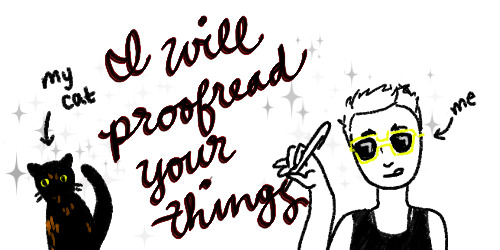
Hello, I'm your friendly neighborhood disabled unemployed transgender queer on the internet. I have not posted a great amount about the details on this blog for privacy reasons, but I am currently in an untenable familial/financial living situation, which I am actively working to get out of. My primary barrier to disentangling myself from the pertinent parties is a lack of income. I've been unable to pursue traditional means of work due to being multiply disabled (slash chronically ill, slash treatment-resistant, et cetera...), but I do not qualify for SSI or unemployment, so I am stuck trying to find other ways of making money.
This is where you come in... If you'd like to help, you can:
$$ Hire me $$ to proofread your fics, essays, and more!
Click below for info! (I also may add separate posts for diversity reading and/or other writing- and editing-related services.)
For $0.00855/word *OR BEST BID*, I will vet your work of writing before you publish it, checking for mistakes in spelling, capitalization, & punctuation, missed words, inconsistencies of tense, formatting, & POV, and miscellaneous grammatical errors. Never again need you fear posting a finished chapter and discovering a slew of typos after the fact; no matter how sleep-deprived or late at night the state of writing, I will ensure your text is ship-shape. Or, if you happen to be interested in having other types of writing proofread before submission--essays, comics or webtoons, letters, transcripts, compositions of a personal nature, so on--I will happily take these on at a comparable rate.[1]
Qualifications:
Bachelor's degree in English with a minor in writing
Initiate of international collegiate honors society for English scholarship, Sigma Tau Delta
Active member of the International Association of Professional Writers and Editors (IAPWE)
Former lit editor for award-winning university literary arts magazine
Prior employment in tutoring and teaching English, as well as copy-editing and content writing
Nearly 20 years' writing experience
Previous experience as both fic writer and beta
Incisive eye for typo-hunting and tenacious attention to detail (I have high standards and will make those everybody else's problem... now for pay!)
I will read for content of any genre and all ratings, and am broadly[2] open to any subject matter, kinks, et cetera. I'll also post more detailed guidelines (booking process, any exclusions, additional criteria) on a separate, unrebloggable post so that any edits and updates are always current.
Message me via the chat feature on Tumblr, or send me an e-mail (I will post it on my more info post) to request a quote, bid for a slot, or just to see what I can offer for whatever project you have in mind. And please feel encouraged to share or boost this post! I am in urgent need of any income I can get, and every share counts 😭🙌
. . . . . . . . . .
Proofreading Full Details · Other Services · Support Me (alternatively, Tip this post!)
- - - - - - - - - - - - -
[1] There will be some exclusions to this, such as academic assignments/papers that have style guide requirements; i.e., I will not be your online MLA style checker or anything.
[2] As with anything, there will be sporadic exceptions to this as well, but I will always be up-front about such cases.
#proofreading#fanfic#writing help#for hire#authblr#ficblr#writers on tumblr#writeblr#other tags??? idk help me out here#proofreading post#this is tumblr let's all pretend this post is as professional as it gets and that i don't have any obsessive compulsive disorders at all
70 notes
·
View notes
Text

Mattie Lubchansky is a cartoonist and illustrator living in beautiful Queens, NY. They are the former Associate Editor of Ignatz and Eisner award-winning magazine and website The Nib. Their work has appeared in The Nib, VICE’s science fiction vertical Motherboard, Eater, Mad Magazine, Gothamist, The Toast, The Hairpin, Brooklyn Magazine, New York Magazine, Food and Wine, Current Affairs, and their long-running webcomic Please Listen to Me. They are the author of Simplicity (Pantheon, 2025), Boys Weekend (Pantheon, 2023), The Antifa Super-Soldier Cookbook (Silver Sprocket, 2021), the co-author of Dad Magazine (Quirk, 2016), author of Skeleton Party (self-published, 2016), , co-editor and contributor to The Nib’s anthology Be Gay Do Comics (IDW, 2020) , contributor to the Lambda Literary Award-winning anthology 2 Trans 2 Furious: An Extremely Serious Journal of Transgender Street Racing Studies (Girl Dad Press, 2023), and co-editor and contributor to the Eisner-nominated anthology Flash Forward: An Illustrated Guide to Possible (and Not So Possible) Tomorrows (Abrams, 2021). They were the Herblock Prize finalist in 2020.
18 notes
·
View notes
Note
Why has the American comics industry been so adverse to unionization? I've been reading through the Comics Broke Me hashtag on Twitter and I've realized how difficult it's been to even get meager compensation for work that provides the backbone for billion dollar smash hits.
I would highly recommend Abraham Josephine Riesman's biography of Stan Lee, True Believer, both as an excellent portrait of the man himself and how his industry changed across the decades. (Bell and Vassallo's Secret History of Marvel is also quite good on the early history of the company.)
When the comics industry emerged out of the pulp and magazine industry in the 30s, it was not the "backbone for billion dollar smash hits" that it is today - it was a low-rent, fly-by-night industry that was associated with pornography and organized crime. Notably, it was also an low-cost industry that sold a very cheap product (the original 10-cent comic was about $1.80 in today's money) to children. More on this in a bit.
Even when it suddenly experienced a sudden increase in popularity with Action Comics #1, everyone in the industry thought that it was a passing fad that would be temporary - and so there was less resistance to the work-for-hire system that bosses like Martin Goodman used to keep their costs down. Not no resistance - as Riesman notes, Jack Kirby and Joe Simon got pissed when Goodman started stiffing them on the profit-sharing from Captain America, so they started moonlighting at D.C, Stan Lee found out and snitched on them to his cousin-in-law/boss, and that led to them getting fired - but less.

However, there was another reason why it was hard to start a union in the comics industry, which is that a lot of comics creators were vaguely ashamed or embarrasse to be associated with it. Even before Wertham and the moral panic of the 1950s, comics were (as I've noted above) seen as a bit scuzzy, a form of disposable crass commercial entertainment aimed at an undiscerning audience of children, and certainly not respectable Real Art. While they were trying for their big break into the more prestigious worlds of fine art or literary fiction, writers and artists viewed their work in the comics industry as a day job that was best kept a bit under wraps - hence why Stanley Lieber only used the nom-de-plume Stan Lee for the comics, because he wanted to keep his then-real name for the career in novel-writing that he wanted to have.
Moreover, there was a particular ethnic angle to this distancing. As I've written a bit about before, there was a tendency among Jewish creators of this generation to keep Judaism subtextual and to change their names to keep their own Judaism subtextual - hence Stanley Lieber taking on a more gentile-sounding name, hence even a proud and pugnacious Jewish man like Jacob Kurtzberg choosing to go by Jack Kirby. Partly, this was done as a means of achieving economic opportunity in a society that wasn't exactly welcoming to creators with Jewish surnames. (Hence the line in the West Wing about Toby Ziegler going by Toby Ritchie when he worked as a telemarketer.) This is another reason why these Jewish creators were working in comics in the first place, because the "Mad Men" who ran the advertizing industry wouldn't hire them.
But partly it was done to avoid becoming a shanda fur die goyim - a Yiddish expression that means "a shame in front of the gentiles" - by associating the Jewish community with a (heavily Jewish) industry that was viewed as little more elevated than the schmatta trade in comparison to the prestigious world of art and literature. It's an old story - literally, it's the plot of The Jazz Singer, the first talkie about a Jewish entertainer (in blackface, unfortunately) and his conflict and eventual reconciliation with his more traditional family.
youtube
After comics went through its first big boom in WWII and then survived the crash in the 50s and saw the second big boom in the 60s, a lot of creators realized that the handshake work-for-hire deals that they had started with had screwed them out of a lot of money. This started some very high profile long-running lawsuits, as first Siegel and Shuster and later Kirby and Ditko sought to get a portion of the rights to the characters they had created. (Some of these lawsuits settled only a few days ago, and some are still ongoing.)
As Riesman explains, the Copyright Act of 1976 created an opening for comics creators by requiring that there be a written agreement between a work-for-hire creator and their employer establishing the transfer of copyright. This created an existential crisis for the Big Two comics companies, and the new Marvel Editor-in-Chief Jim Shooter immediately tried to get his creators to sign one-page contracts transferring their rights. Hotshot artist Neal Adams urged creators to not sign the contract and invited them to a meeting at his place to discuss forming a union. Shooter retaliated by threatening to black ball anyone who joined Adams' organization - and this blatant violation of U.S labor law cowed comics creators into signing the contracts and signing away their rights and the drive to unionize comics died the same way a lot of union drives die.
Things have gotten a bit better in recent decades - the 90s comics boom and the departure of the Image guys improved the situation for creators' rights somewhat due to competitive pressure, but there are still significant problems when it comes to comics creators' access to health care, pensions, and other benefits. There have been some recent union wins - the Comic Book Workers United organized Image Comics - but these tend to be unions of staff workers rather than creators. There is the Cartoonists' Co-op, which is looking to move in the direction of acting like a union but is a very nascent organization that's a long way away from that yet. And it remains galling that the most that creators see from the billions made by Disney and Warner Brothers Discovery are $5,000 checks dispensed to keep them quiet.
It's not going to get better until writers and artists unionize.
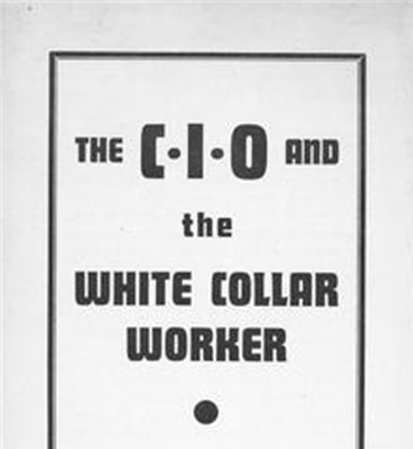
#comics#comics meta#stan lee#jack kirby#jim shooter#labor history#trade unions#jewish history#subtextual judaism#cultural history#marvel#marvel meta#dc#dc meta
188 notes
·
View notes
Text
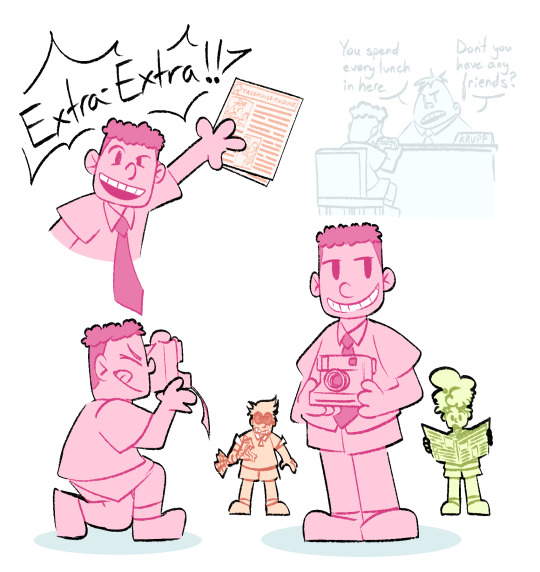
"EXTRA EXTRA! Get the latest issue of the Treehouse Tribune™!"
————
The mad lad himself, George Beard! I've been thinking about this kid a lot in this AU and I'm switching things up a bit.
George is the notorious school prankster but he covers up his tracks well. Many teachers and students assume it's him, because duh, but without proof he can't be punished for the campus wide goofs and gaffs.
George credits the pranks to an entity known as 80-HD (going for a Banksy vibe) and 80-HD is beloved by students who view him as a school urban legend.
Mr. Krupp is 98% sure that George is 80-HD but can't do much about it other than try to keep a close eye on him. He CAN, however, give George detention for his makeshift newspaper, the Treehouse Tribune.
See, without Harold to draw comics with him, George needed an outlet to funnel his creative writing skills. So he made a fake newspaper with made up stories, spoof articles, and a hokey advice column à la Mad Magazine but PG and less political.
Since I'm keeping the characters strengths and weaknesses, George doesn't dare try to draw anything as he doesn't think he's very good. Instead, he has taken up a photography elective to help with his newspaper.
Krupp can punish George for the newspaper distribution and George often ends up having to spend lunch in the principle's office, something he has long gotten used to over the last 4-5 years. In this time, I think Krupp has grown a reluctant soft spot for the young lad, as despite all his pranks, goofs, and silly nature, George hasn't made any real friends at Jerome Horwitz.
George is beloved by students, but not liked by students. He's a 9-10 year old in the 7th grade. Kids in his grade either think he's too immature or are jealous that he skipped so many grades, while kids his age are either intimidated by his grade (because grade politics were a thing in American elementary school) or don't want to associate with him on a personal level.
His antics are admired, but rarely does anyone want to help/share credit/notoriety with him.
He's kinda lonely.
The most OOC thing about Krupp in this AU might be that he feels bad for George. I imagine that, underneath all his mean, principle demeanor, Krupp doesn't actually want to expel George, but rather wants to help him succeed academically. (In the movie, all he did was separate George and Harold, not expel them, cuz they were 9-10 years old!)
So yeah. George is cool, fun, and wacky, but he's lonely and eats lunch with the school principle.
That is...until he formally befriends Harold Hutchins and, reluctantly, Melvin Sneedly.
#captain underpants#george beard#harold hutchins#melvin sneedly#benjamin krupp#principle krupp#captain underpants au#rr au#I feel that man#I used to be someone who everyone KNEW in elementary school#but no one really wanted to be my close friend#Drifting between clicks because they had already formed and I just stuck out#Feels bad george#but dw#you'll be with your buddies soon!#George + Harold + Melvin TEAM SQUAD!#LETS GO#comic#captain underpants comic#Redux Robotix AU
93 notes
·
View notes
Text
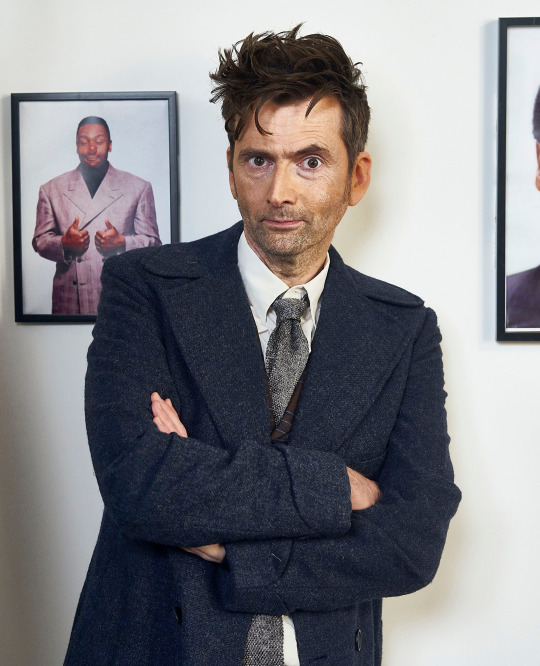
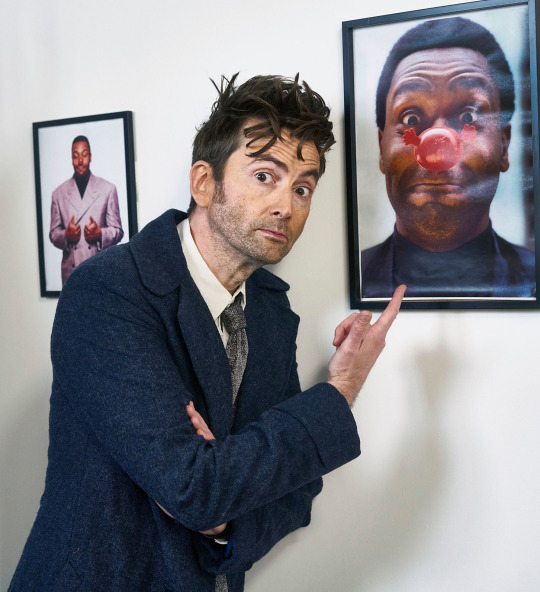
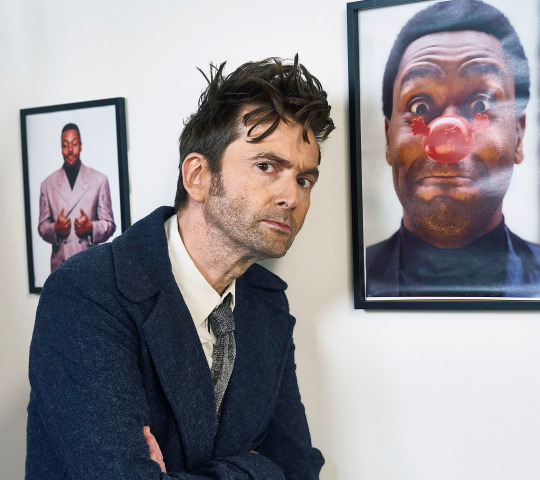

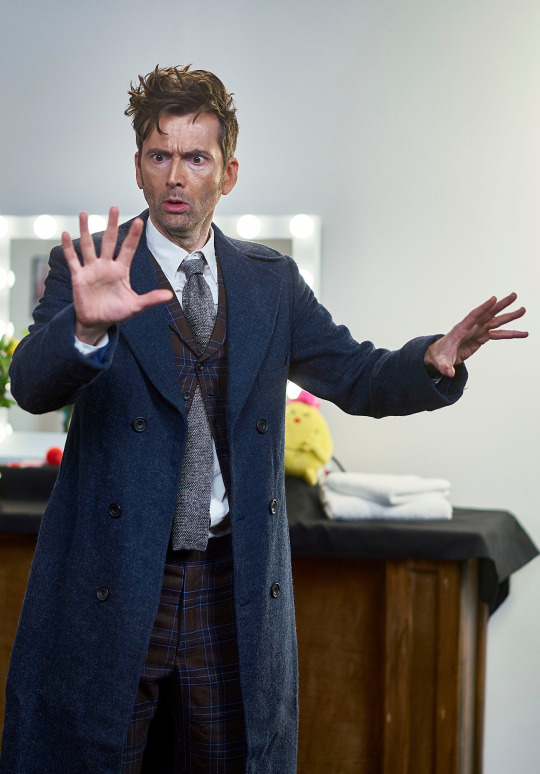

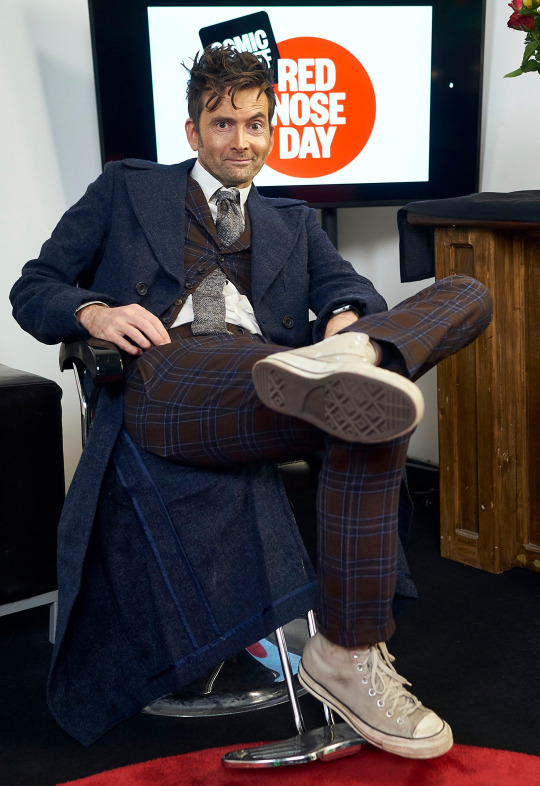
David Tennant / The Fourteenth Doctor at Comic Relief Red Nose Day March 2023
Excerpt from Doctor Who Magazine #589:
Doctor Who executive producer Phil Collinson tells DWM: "A lot of people have thanked us for contributing to Comic Relief when, in fact, we had nothing to do with it! Though we're delighted to be associated with such a good cause. David's always had a long association with them, so the first we knew of it was when a request came through from Comic Relief, asking if we'd be happy with a scene of Sir Lenny Henry regenerating into David. We said, 'Oh yes, fire away, help yourself.' To be honest, I was pleased that they'd even asked, it was very considerate of them! "I think the initial plans were very elaborate, to create a full re-staging of Jodie's regeneration into David. But a message came through a few weeks later - because of schedules and deadlines, they asked if they could simplify it. Again, of course, no worries - we were honoured simply to be mentioned in the same breath!
#david tennant#comic relief#red nose day#doctor who#fourteenth doctor#there may be a part 2 of this set soon#dwm#I appreciate dwm always giving me the extra behind-the-scenes info#I love that kind of stuff#good stuff for a good cause#stuff i posted
210 notes
·
View notes
Text



The Hull of the U.S.S. Bartlesville
The Navy insists the paintings weren't there when she sank.
Prompt: a comic strip with a person and a mermaid, in the style of marvel comics, deconstructive, trompe-l'œil illusionistic detail, cracked, art frahm, frogcore, associated press photo:: full-page photoshoot in pictorial auto magazine, lemurian 35 year-old gorgeous attractive 150lbs plus-size model attractive woman, standing next to rusty sea bunker entrance
#unreality#midjourney v6#generative art#ai artwork#public domain art#public domain#free art#auto-generated prompt#ai girl#mermaid#rust
16 notes
·
View notes